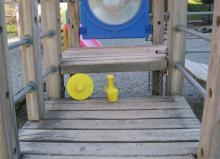
A “completely bounded opening” is defined as: “…any opening in a piece of play equipment that is totally enclosed by boundaries on all sides so that the perimeter of the opening is continuous.”1 A completely bounded opening may be either rigid or flexible. Rigid openings are found in such components as stairs, barrier panels, and handholds. Flexible openings are found in such components as net climbers and some plastic enclosures.2
Completely bounded openings are a hazard that playground inspectors are taught to look for as they may cause a head entrapment, a potentially life threatening hazard. Even openings low enough to let a child’s feet touch the ground can present a serious threat as young children may not have the skills or ability to free themselves if entrapped.3
In order for a completely bounded opening to be considered an entrapment, it must be “accessible.” An opening is considered accessible when a torso probe can be inserted into it to a depth of 4.0 inches. For example, if a step ladder is being tested and there is a vertical wall behind it prohibiting the probe to enter to a depth of 4 inches, the opening is not considered accessible.
A completely bounded opening is tested by first inserting the torso probe to a depth of 4 inches or more. If the torso probe can be inserted, then the head probe must also pass through the opening. If it doesn’t pass through, the opening fails and it is considered a head entrapment.4
A flexible opening is tested by first attempting to insert the torso probe. If the probe passes through the opening, using a force of 50 pounds, then the head probe must also pass through or the opening fails.5
Completely bounded openings with an opening between the bottom edge of the equipment and the protective surface are exempt from the head entrapment criteria.6
- 1. ASTM International Standard F1487-11, “Standard Consumer Safety Performance Specification for Playground Equipment for Public Use,” Section 3, p. 3.
- 2. Ibid., Section 6.1.2, p. 5.
- 3. US Consumer Product Safety Commission (CPSC) publication 325-10, “Public Playground Safety Handbook,” Section 3.3.1, p. 15.
- 4. Op. cit., ASTM F1487-11, Section 6.1.1, p. 5.
- 5. Op. cit., ASTM F1487-11, Section 6.1.2.1, p. 5.
- 6. Op. cit., ASTM F1487-11, Section 6.1, p. 5.

